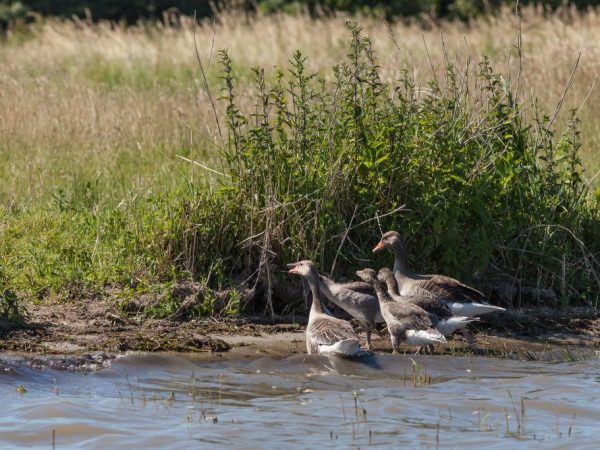Characteristics of Tula geese
The Tula fighting goose is a well-known and old breed that enjoyed a certain popularity. Tula geese were fed as participants in goose fights - a popular entertainment in those days. On the territory of some regions and states, such competitions continue to be popular, and with them the indicated bird.

Tula geese
Short description
Given the specifics of the breed, these geese are called Tula fighting geese, and it is this name that stuck among the people. Thanks to constant artificial selection, modern representatives of the breed are distinguished:
- fortress;
- by force;
- endurance.
Thanks to the listed characteristics, the breed has become an ideal example of natural fighting performance. The appearance of the Tula geese is impressive, because during the period of active breeding, the appearance has become perfect. It should be noted that the indicators of strength and endurance are successfully combined with a small body mass, which has a developed muscular system, and is also characterized by a high density of the structure.
Characteristics and features
A feature of the species is the high similarity of individuals to each other. First of all, this similarity is based on a small variation in colors, there are only three. Tula fighting geese can be gray, clay, white. The gray variety has a visual similarity to wild representatives, but they are somewhat larger. The Tula goose with a clayey feather color is called Kaluga and is quite common. White geese of the Tula breed are more common in a number of regions.
Another factor that makes it possible to carry out the necessary gradation within the subspecies is the beak, which today distinguishes three more species. They can be down-nosed, straight-nosed and steep-nosed. In this classification, it is the shape of the beak that comes out on top.
- False-nosed individuals have a beak that is slightly concave inwardly.
- The straight-nosed Tula fighting goose has a beak, the upper part of which is absolutely even.
- Tula geese of the steep-nosed type have beaks that are shortened and curved outward.
The above-mentioned features are almost the only characteristics that make it possible to establish diversity within a variety. Characteristic features include a small, oval-shaped head and a flat forehead. The beaks of most individuals are somewhat shortened and are strong and sturdy. Also characteristic is the thickness of the neck and the depth of the chest, which are superior to the average of other breeds. Fighting Hump-nosed geese, among other things, have strong and rather short limbs, powerful, large and strong wings, which are actively used when entering the next battle. A strong wing swing performed by the Tula fighting goose can cost the enemy health.
Production
Tula geese are birds that can hardly be classified as highly productive species.Experts note a low level of profitability for meat, egg products or fluff. Small farms (mainly households) have several individuals. The indicators of the breed make it possible to class it as medium-heavy, since the weight of the “men” reaches 7 kg, while for the female the maximum indicator is 6 kg. The record figure is 8 kg.
Females have well-developed maternal instincts. Young geese are capable of producing about 25 eggs during one cycle and hatching them independently. Due to the presence of a strong immune system, the safety indicators of chicks are at a fairly high level. Small Tula geese are able to quickly gain weight even in normal pasture conditions. The peculiarities of the development of the breed are such that even without the use of a special food base, a young bird at the age of 2-3 months can reach a body weight of up to 4 kg. Tula fighting geese can graze in open areas, since they can easily tolerate both hot and cold natural conditions.
The list of shortcomings of the breed can include the presence of a red tint on the beaks, eyelids and eyes, since such formations clearly indicate a genetic abnormality. Among other characteristics indicating that Tula fighting geese cannot be used in battles, it should be highlighted:
- uneven back;
- deviations in the structure of the wing;
- fatty folds in the lower abdomen.
Bird and fighting
In order for a goose to be selected for a battle, it must be distinguished by an aggressive character, a large physique. It is important that the fighting geese are not injured. It is the fighting qualities that prevail, but this does not mean that such individuals are not suitable for home cultivation and breeding.
Even the smallest poultry house can be supplemented with the birds in question, which will become a real decoration of the entire farm. To get the most out of this venture, you need to read the breed guidelines and consult with experienced breeders.
It is noteworthy that some poultry breeders may not be aware that they have these representatives. For complete information on visual characteristics, you can consult numerous sources. So, Tula geese, photos of which are posted on the Internet, are able to satisfy the interest of everyone. Such photos are of very good quality, and therefore make it possible to identify and determine all the available features.

